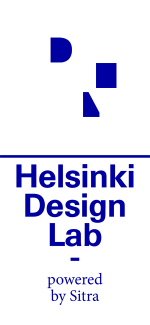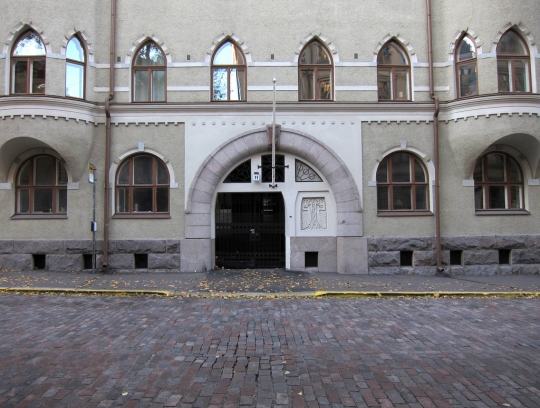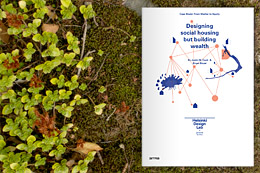All posts tagged Food
The air is increasingly crisp as autumn falls upon Helsinki. And yet summer is not giving up without a fight. This week we enjoyed one of the warmest September days on record. It does feel warmer than last year about this time.
We have been taking advantage of the weather by getting in a few last exploratory walks for lunch or mid-day coffee. As winter sets in the radius of lunchtime possibility closes down and the daily rituals change. We try to take as much advantage of the warm months as possible, often working in cafes, libraries, or other nooks around the city for half the day or so. As it cools off we'll be spending more time in the mothership.
Beyond the niceties of a good lunch, food has been a focus lately because of a bit of work we're doing. Street food, in particular, though we're taking a rather wide interpretation of the term. More on this soon, as we are preparing a slim publication on the topic. But the gist is that we're interested in how food cuts right to the nexus of so many interlocking systems. While it is deeply cultural, ephemeral, and literally a mater of taste, food is also an essential current in the hard flows of economics, health, and logistics.
As we pursue ways to positively affect the systems that shape daily life, we are searcing for entry points. The essentialness of food makes it a great candidate to act as a tangible pivot or hinge which allows us to research, observe, and design simultaneously at a very minute level where execution is direct and feedback loops are quick, as well as more abstract and systemic levels which on their own lack immediate feedback. More on this as it develops.
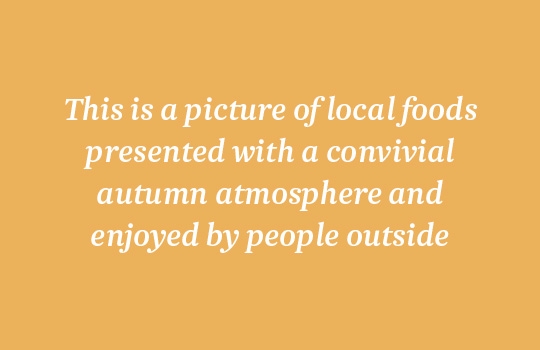
And it used to be a real picture of the Fiskars Slow Food festival held this weekend. That was until my camera decided to reformat its memory card.
University of Helsinki have recently published a video. It features a herring and it is a nice video.
From food to space. The other topic on high rotation within the team is community decision making. How do we make decisions together? And more specifically, how do we make decisions when it's not possible to agree to disagree, such as when there's a chunk of the city involved. A park, a disused lot, a nice corner, a store front. That kind of thing.

Borrowing from Nolli and thinking about more rigorously pursuing his technique of mapping the public realm.
Although this is a very nascent topic for us as yet, we've been doing some sketching. This one in particular is a quick study of the 'hidden' courtyards of Helsinki. Although the city is full of wonderful interior courtyards, they're mostly out of sight and really quite out of mind. How could these spaces become more of an asset to the city?
Both of these projects are orbiting around ideas that we explored with Clues to Open Hesinki, a pack of 'postcards from the future' that we created with the help of OK Do last spring. And while both the food and the courtyards have come back onto the radar through their own paths, it is interesting to reflect on the fact that they were also amongst the dominant themes of the conversations we had when developing Clues. I suppose I should say that it's gratifying, actually. The small bet we made with that project is now repaying its dividends and proving to be useful preliminary research for two projects which have their own focus at a new scale of ambition.
A small note about the book: I've updated the page to include information about where to find it in book stores. Currently there are only two, but I'm hoping to have time to work on expanding this list a bit. If you have suggestions for appropriate shops in your neck of the woods please leave a comment here.
Other projects: Justin continues to tweak the Low2No website, which is overflowing with details about the project; Marco had some promising meetings relating to the exchange, as well as work related to World Design Capital; Dan has been wrapping up some essential elements of groundwork for the smart systems aspects of Low2No as well as writing about food; I was out half the week on a mini-break and then handling the technical bits of the Low2No site; and Johanna is handling logistics and administration steady as ever.
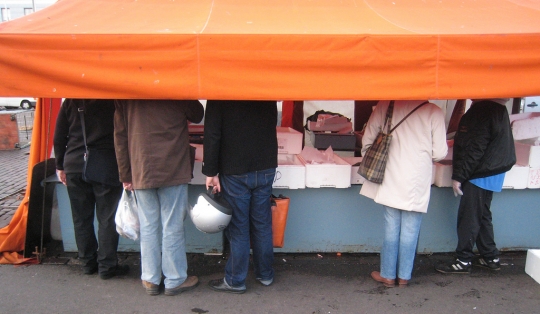
Justin enjoyed the Herring Fair three years ago.
To close this weeknote I'll leave you with a link to MindLab's wrap up summary of their How Public Design? event that Marco and I enjoyed last month. Have a look—we'll be doing the same, perhaps after a visit to the Helsinki Baltic Herring Fair.
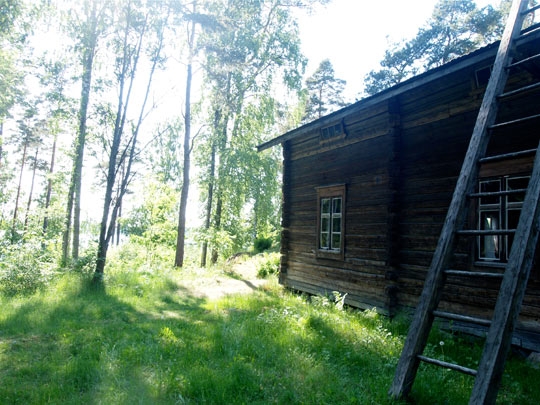
Summer on Seurasaari
Helsinki is now basking in full summer, with a couple of days touching 30 degrees this week. The city is glorious like this, with every inch of street, park and pavement full of life, and islands like Seurasaari become impossibly appealing places to spend a Sunday afternoon. Like opposing points of a compass, Helsinki can be differently beautiful in hot sun/midsummer and deep snow/midwinter—it's the bits in between we have to work on.
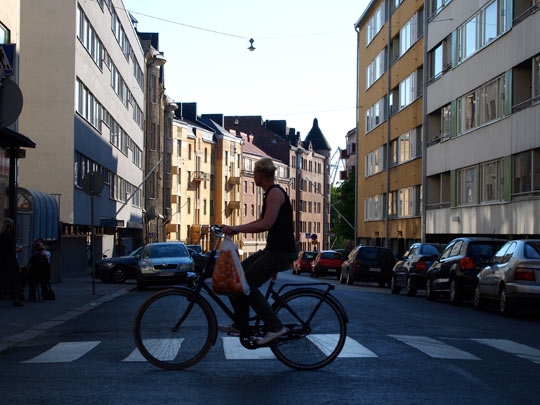
Or work in, perhaps. We are all horribly aware of the month-long summer holiday slowly approaching, in much the same way that Christmas creeps up on British workers. Both are looked forward to, of course, but both compress time either on either side, leading to an increasingly frenetic rush of meetings and proposals.
This week is no exception. Personally, my work on Low2No is beginning to pick up pace, meaning meetings with various people inside and outside Sitra—including a chance to catch up with our partner Irene Cassarino from Experientia, and researcher Tiona Zozul from Harvard Business School—as well as making the most of Justin being in town. Both Justin and Marco were heavily focused on Low2No this week, though also helped guide our other various project ideas into our other various programmes, before Marco disappeared for a well-earned week of R&R in southern Italy and Justin took off to hold the fort back in Boston.
Bryan knocked off some significant milestones in completing the first in what will hopefully be a series of HDL books, exploring the process and potential of strategic design in this context. More to follow on all this, when the time is right.
A couple of weeks ago, I wrote an article about Helsinki for my old employer Monocle magazine (see forthcoming July/August edition on liveable cities) and in doing so I spoke with both Mayor Jussi Pajunen, and the City's project manager for their 'food culture strategy', Ville Relander. Both emphasised how the City's burgeoning food scene has become a weathervane of the changing Helsinki, and perhaps Finland, which has also played to our own interests in food as an area of potential systemic change with regards to sustainable well-being—at least when food is viewed as a deeply cultural and complex field of interdependent networks and supply chains, which affects everyone and all places, one way or another.
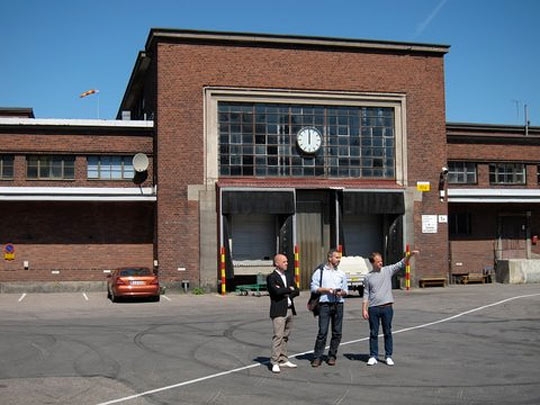
Justin and Dan meet Ville Relander.
So on Wednesday, Bryan, Justin and I went to visit Ville up at his temporary HQ, the city's old wholesale markets amidst the urban regeneration of the Kalasatama area. The markets are a core part of the city's food culture strategy, with the idea that they become a social space as well as a place to source ingredients, perhaps akin to London's Borough Market, Melbourne's Queen Victoria Market or Barcelona's Mercat Santa Catarina, but refracted through the prism of Nordic cuisine and public space.
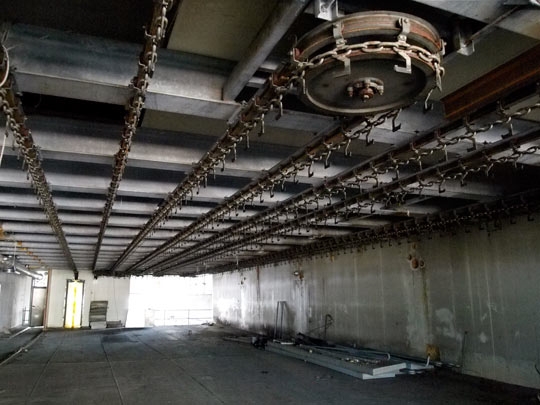
Sikasirkus, or 'pig circus'
The main slaughterhouse building is an incredible asset, with a sturdy yet elegant, long low form that is perfect for re-appropriation, and some horrifying/appealing features such as the sikasirkus (yes, that translates to 'pig circus') for transporting pig carcasses through the building. The place still smells fairly porky, but has huge potential.

Wholesale market at Kalasatama.
Ville is clearly an asset too, of a very different kind, and he spoke with enthusiasm and insight about the City's approach to food. The City of Helsinki has significant impact on the food business, not least due to the fact that tens of thousands of hot meals are served every day in the City's kindergartens (päiväkoti in Finnish)—where most kids go to pre-school—and so its aspiration to make half of this kindergarten food organic by 2015 could impact positively on supply chains across the region.
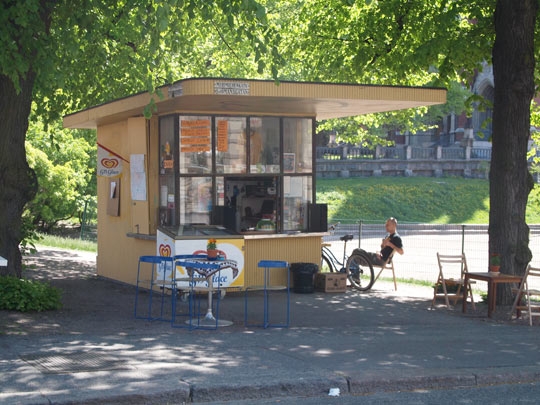
But the City can equally impact the street and its food too. As noted previously, we're researching this area very closely—currently, The Saga of the Camionette, and What It Means for Helsinki. Watch that space.
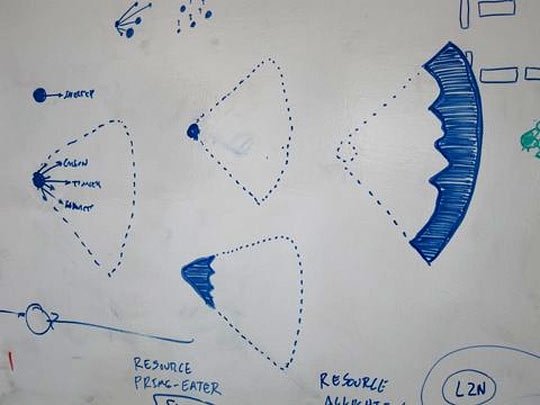
Sketching systems.
This also means we're diagramming furiously of course, both for the aforementioned book and also generally, trying to find ways of suggesting a strategic design approach that connects 'the päiväkoti and the camionette'.
Which leads me to a brief note on whiteboards (to follow up our previous on Post-its). Given our rhetoric around 'designing the conditions' around systems, it's only right that we look at our own working environment from time to time. And this last week's iCloud announcement from Apple, combined with our ongoing fascination with services like Square, had Bryan and I trading ideas back and forth, not just about new public and private services made possible by such advances, but also our own workspace.
Accordingly, we've been developing our internal 'knowledge management' systems (hacking together Tumblr, Dropbox, Basecamp, Twitter, Facebook and various other more bespoke systems), the hardware we use (including gearing up for more video, perhaps saving you reading all these words every week), and conjuring up entirely new approaches to sketching and scheduling on our floor-to-ceiling whiteboards.
It's interesting how bespoke this all is—how workflows, tools and culture are hardwired into the particularities of teams and places—and that despite attempts to systemise this, bespoke feels right.
Anyway, if the whiteboard system works for more than a few weeks, we promise a full exposé at a later date. If it doesn't, forget I ever mentioned it.
As June begins we've been working on a number of small bits: helping some of them grow into slightly less-small bits, and eventually real projects. In other words, sketching, discussing, calendaring, prioritizing.
On Thursday we had the luxury of spending an entire day to look at only two issues. That much time dedicated to such a limited agenda is nice and by the end of the day we were all exhausted.
What else? Some quick hits:
Dan was at Aalto University to give a presentation in the Pragmatic Utopias seminar
We at Sitra launched a new website in beta form. This has been a long time coming and we're excited to have it as a more fluid way to share our work. You can read about strategic design in English and in Finnish (and more content will be available in English in the fall).
HDL can now be found on Tumblr, where we are blogging things that look interesting and related to strategic design. If this experiment works out we will figure out a way to bring some of that content onto this site as well, but for now it's in a separate sandbox at helsinkidesignlab.tumblr.com.
So let's face it, if you're reading this site and you just thought about clicking that link for the Tumblr blog, then perhaps it's time that we make our friendship official. Luckily, Facebook is here to help us Become Friends. In other words: HDL can now also be found on Facebook, where you can can give us a thumbs up if you're inclined. Or generally follow along with what we're doing.
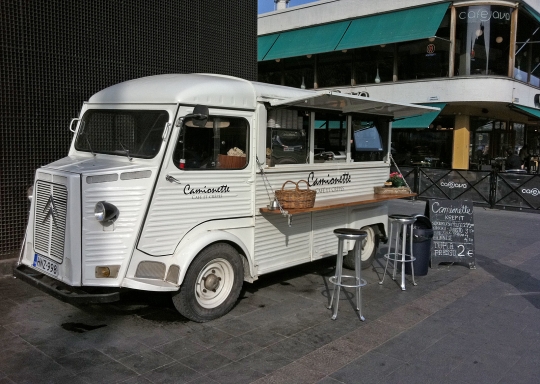
Being open 24/7 gives the operators of Camionette a valuable perspective on the affect of their offering on the street culture around their truck. Hint: It's much different at night.
And finally, the Strategic Design Unit has been talking a lot about street culture, and in particular the way that food helps set the tone of the street. This was aided by a visit to Camionette, Helsinki's first food truck. Tasty.
March is a good name for this month. That's what it feels like: a march. Summer is already just around the corner but there's a lot to be done between now and then. These past two weeks have mostly been about sharing.
Sharing with other teams at Sitra, sharing with the world via writing, and sharing with similar organizations who are developing new ways of working on comlex problems.
Marco and I continue to work with the Synergize Finland team as they will be using the Studio model this May. I gave them a brain dump on what a Challenge Briefing is, what role it plays in the studio, and how you structure a similar document. They're off and running on briefings for their studios and it will be cool to see the concept reflected back to us through their experience with it. Marco has been recruiting designers to play the role of studio lead.
During the past two weeks we've also submitted three article for publication on three continents. Two of those discuss the Studio model in greater detail, and the third looks at strategic design vis-a-vis the practice of architecture. We'll post links here when they are available—I believe the first will be the forthcoming issue of Volume Magazine on Ageing.
It feels great to have these deadlines behind us, and I wish I could say that the typing hands can rest now, but no! We soldier on with another big deadline for a draft due in the middle of March. This one is a self-imposed deadline to more thoroughly document the Studio model and our three studios last summer.
On the topic of studios, we caught this interview with John Seely Brown on the radio in Australia (mp3 link):
"In a world of constant change, [design is] the ability to imagine, the ability to take close assessments of where you are versus where you want to be, and figure out how to move from here to there. Design was a nice thing to have in the last few hundred years in a world of stability, but really the form of productive inquiry underlying design is now critical in a world of constant change.
Basically we're living in a world now where our skills have about a 5 year half life. when I started out doing stuff it was a 30 year half-life, so today we have to be at any age able to pick up brand new skills... The studio is one of the most concrete ways of working with the real, working with the concrete, letting the imagination fly, and then collectively with folks around you and mentors actually produce new knowledge."
We were out and about too. I gave a talk to Aalto University's Creative Sustainability course. Marco was in London to participate in the Ecobuild conference and share some of our experiences with Low2No. Afterwards he and I spent a morning catching up up with Nick Mabey at the HQ of E3G. They've just published Degrees of Risk which I haven't had time to read, but knowing Nick and his team it's should be thorough and insightful.
Degrees of Risk is the output of a multi-year process working with climate scientists and security experts to flesh out a framework for moving to a risk management approach to climate change, in contrast to the singular focus on migitiation. Doing so implicates a much wider array of decision-makers, from security to infrastructure, each with established ways to plan for future risk. The framework is an intensely clever way for hacking the climate debate to put it into terms that a larger group of people—everyone—gets: risk.
And now for an abrupt transition: from climate risk to sea ice. Under an unusually bright Sunday sky, I went for a walk on the sea ice last weekend to do a bit of research on Helsinki food culture.
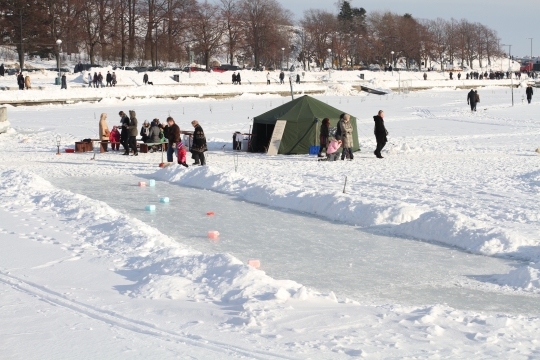
Temporary cafe set up on the ice... and curling sheet!
One of the delightful things about northern cities is the degree to which their geography changes during winter. Helsinki comes alive with recreational opportunities all across the frozen sea. Suddenly the isolated boat gas station becomes a winter cafe, with a new arrival path across the iced-over harbor. Remote coffee shops have new streams of guests who come to roast sausages on outdoor fire pits. Or have a curling match. This won't last for too much longer, given the warm weather we've been having, so I'll have to wait for next year to corral my colleagues into starting the Sitra Curling team.
Week 102 closes with a steady hum—and the clickety clack of more writing.
